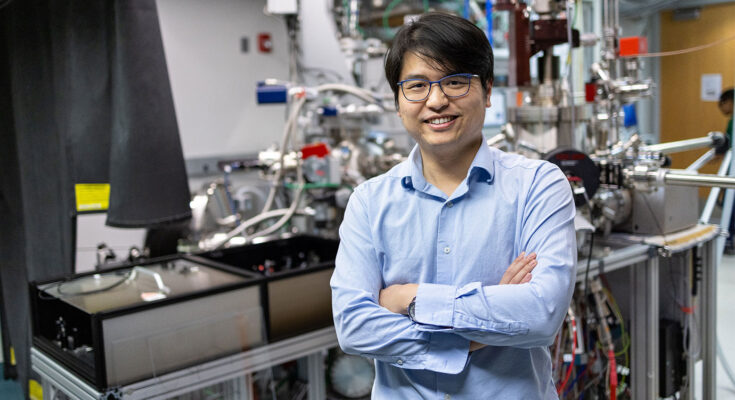A water supply that could help NASA set up a permanent lunar base is preserved—or trapped—within craters so deep, the bottoms haven’t seen the sun for up to two billion years.
As most of the vehicles and machinery someday used on the moon will likely be solar-powered, this is a problem. But a new NASA grant will help University of Chicago Pritzker School of Molecular Engineering Asst. Prof. Shuolong Yang on his search for a solution.
NASA recently named Yang one of eight recipients of an Early Career Faculty Award to support research that’s “critical to making science, space travel, and exploration more effective, affordable, and sustainable.”
The grant will help Yang develop a high-temperature superconducting cable, one that can be built into others that will send power to machinery seeking ice deep within the moon’s “permanently shadowed regions.” It’s a bold plan for procuring water to drink, grow crops, split into hydrogen for fuel and oxygen to breathe, and otherwise make the lunar climate habitable.
“If we can make a high temperature superconducting cable to transmit the power—without power loss—from a moon base to the remote rovers or vehicles or other machines, this would be a great solution for getting the water needed to sustain life on the moon,” Yang said.
Moonshadow
The Earth’s tilted axis means the north and south poles are blasted with sunlight for months at a time—the famous “midnight sun.”
The moon, however, is basically vertical in relation to the sun, so the polar regions are never pointed directly toward the light. That means sunlight comes in at such an angle that the bottoms of about 324 deep craters, mostly clustered around the south pole, are perpetually shrouded in darkness.
This keeps the depths of the craters cold—about 40-50 degrees Kelvin, or almost -370°F—and the perfect venue for frozen lunar water.
Although these temperatures are cold for water and astronauts, they’re warm for superconductors, many of which reach peak conductivity as close to absolute zero as possible.
Though there already are superconductors that work at such temperatures,technical issues make them less than ideal for the bendable, snakelike cables that crater-exploring rovers would need.
“Their performance is highly direction-dependent,” Yang said. “The superconducting properties vary dramatically along one direction versus 45 degrees off that direction. That’s the intrinsic nature of these copper-based superconductors.”
Yang said it’s possible to get around that hurdle by orienting the crystals in those copper-based superconductors “very, very carefully,” but he and his team at UChicago PME have created a solution that avoids that issue entirely.
“This would be a great solution for getting the water needed to sustain life on the moon.”
A superconducting sandwich
Yang and his team plan to sandwich a thin membrane of iron selenide between two protective layers of strontium titanium oxide. This would create a bendable, stretchable tape that both superconducts at the temperatures found in lightless moon craters and could be fashioned into the electrical transmission lines running power from moon base to rover.
“You can basically place it onto a different platform—it could be a more stretchable platform,” Yang said. “It could be a more easy-to-manipulate platform, as long as the membrane is superconducting.”
Yang credited the NASA award for looking to unconventional, outside-the-box thinking for solving larger issues.
“I am glad that they appreciate bold scientific thinking, and they encourage people to come up with solutions from their own scientific disciplines,” Yang said.
Yang hopes his and others’ research will continue to help humanity look to the stars.
“This is what our society and our species have been doing for thousands of years,” he said. “We need to continue to do that, because there are a lot of exciting things happening in space.”
Originally published through the UChicago Pritzker School of Molecular Engineering.



